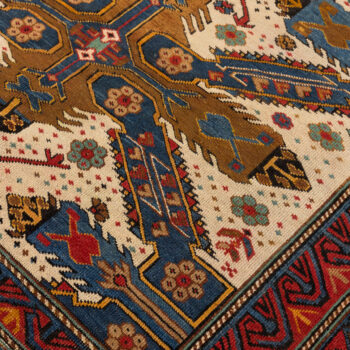Seychour

Antique Caucasian Seychour rugs are an expression of the hearts of the people who created them. In a rugged terrain that lies between the Caucasus Mountains and the Caspian Sea live a people who have carved out an existence and produced some of the most beautiful ancient carpets in the world. The area is currently in modern-day Azerbaijan. Kuba (Quba) is one of the largest cities in the region and is famous for its carpets produced by the small ethnic groups that surround it.
Caucasian Seychour rugs are also known as Seichur, Zeychoura and Zeikhour. They are made in the small village of Yukhari-Zeykhur in the northeast Caucasus. The carpets produced by this village are known for their intricate designs and saturated colors. Seychour was first mentioned by travelers as a weaving center only at the beginning of the 19th century. However, at that time, few Europeans visited the region and saw these magnificent works of art. It was only after 1870 that the Trans-Caucasian Railway allowed the rest of the world to see these beautiful works of art.
A large part of the people who inhabit the villages of the Caucasus came as immigrants, often displaced from their traditional lands. They include people of Jewish, Christian, Buddhist, Muslim, German, Russian and Nordic descent. At one time, there were more than 300 ethnic groups in the area who spoke more than 150 languages. The Seychour are Tabasarans of Russian descent who speak a dialect related to Lezgi. They are loyal to their cultural traditions and art forms.
The Kuba region has been a center of the art of carpet making since the mid-18th century. The ethnic groups that inhabit the city’s surroundings include the Chi Chi, Konagend, Karakashly, Alpan-Kuba, Perpedil and Seychour. Each of these groups produces rugs with unique designs, colors and technique. The rugs produced by Seychour are some of the most beautiful and valued in the world.

The weavers of Seychour are inspired by nature and the landscape that surrounds them. They often use vibrant geometric patterns and locally available materials. In general, ancient rugs from the Kuba region use wool as the warp and weft, but occasionally they also use cotton. They typically use the symmetrical or Ghiordes carpet knot. Kuba rugs are sometimes incorporated into Shirvan rugs, but Kuba rugs can be distinguished from Shirvan rugs by their ribbed structure and higher knot count. Carpets throughout the region differ from village to village in design and style, but many of them learned their techniques in the Kuba school, which unifies them as a group using the same structural weaving elements.
Seychour rugs are considered a subtype of rugs from the Kuba region. Designs may vary, but there are certain characteristics that distinguish Seychour rugs from those produced in other parts of Kuba. The warps are typically beige, ivory or gray and are made from undyed natural wool. The knots and weft are made of wool brightly dyed with colors that were produced with plants found on site.
There are different types of carpets produced in Seychour. They include pile rugs and some Soumak pieces, which is a type of stitch that wraps around the warp and forms a flat-weave rug similar to kilims. These are less common than hand-knotted pile rugs.
The symbols and motifs used by different ethnic groups are a way of distinguishing the village in which the carpet was produced. Seychour rugs are famous for many reasons, including the Seychour rose, as it became known. The rose rug is a Caucasian version of designs that were influenced by European tastes. The design consists of a field full of roses and a richly crafted border. They are often found in bright colors and were made for European Victorian homes.
Another common design is known as the “Seychour cross,” a design that is more of an X than a cross, repeated across the rug. Another distinctive feature of Seychour rugs is the use of what is known as a “running dog” edge and is sometimes simply called a Seychour edge. The number and types of borders vary in Seychour rugs. They can have one edge, two edges, or none. They often use the running dog border surrounded by a plain red inner border to separate it from the main field of the carpet. Seychour rugs usually have a yellow, ivory or green field.
Green is a special color because it requires a complex dyeing process that involves first dyeing the wool blue using indigo and then dyeing it yellow to produce green. Seychour rugs are prized for their highly detailed depictions of flowers and other motifs, as well as their beautiful saturated colors. The rose and the Seychour cross are the two main designs that distinguish the rugs in this group. They are antique Caucasian rugs of exquisite quality.

Figalli Oriental Rugs
We do not sell rugs. We bring rare works of art to your home in the form of rugs.
Our services
You are Protected
Copyright © 2023 Figalli Oriental Rugs, All rights reserved. Desenvolvido por Agência DLB – Agência de Marketing Digital em Porto Alegre




